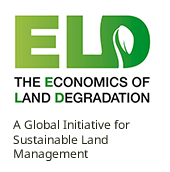Resource information
The Lawra district of the Upper West region was selected as the case study. This study compared crop yields for FMNR and non-FMNR farmers. FMNR farmers are classified as having at least 8 trees per acre, with an average of 13 trees per acre (33 per ha) and a maximum of 40. Non-FMNR farmers are classified as having between 1 and 7 trees per acre, with an average of 5.Qualitative (focus group discussion) and quantitative (household survey) data were collected in April to May 2019. Over 500 households were interviewed in both CIKOD intervention communities and control sites. Data from the survey were used to undertake production function analysis and assess the contribution of farm inputs and farming practices on crop yields. Key findings 1. Farmer Managed Natural Regeneration (FMNR) constitutes a long-term investment in soil quality.FMNR and crop rotations enable farmers to increase the productivity of their cropland by at least 83 per cent within five years. As tree density increases so does crop yields. 2. FMNR communities are considerably more food secure and climate resilient.In qualitative terms, focus groups discussions showed that FMNR farmers are more food secure relative to non-FMNR farmers since they can harvest a wide range of on-farm forest products (fruits, nuts and pods) during the lean season when they otherwise would face food shortages. The average present value of enhanced forest produce (ebony fruits, shea nuts, dawadawa, mango and fuel wood) and crop yields as a result of adopting FMNR and crop rotations is in the order of GHS 255per acre per year (EUR 102 per hectare per year). 3. FMNR creates co-benefits by addressing multiple problems simultaneously.These problems include land degradation, food insecurity, fuel wood, and timber and fodder shortages. By combining FMNR with other Sustainable Land Management (SLM) practices, agricultural yields can be further improved. Moreover, well-conceived FMNR projects facili-tate good governance, greater collaboration and community cohesion. Significant obstacles to up-scaling remain however, ranging from insufficient fire management, low and poor availability of rural credit, contradictory policy incentives and the absence of strong land and tree tenure. NGOs, the private sector and govern-ment agencies, can address different aspects and help create an enabling environment for farmers to practice FMNR. See also recommendations: For landusers❚ Invest in FMNR for long term diversified returns;❚ Intercrop with legumes, make use of crop rotations, compost, mulching and tied ridges for higher agricul-tural productivity;❚ Other SLM activities can be adopted to build the long-term health of soils. For NGOs, international development partners and lending institutions❚ Empower community leaders to prevent fire and man-age fire, the very basis for FMNR; ❚ Empower farmers to monitor and track changes to help improve access to investment capital and man-age their farming enterprises better;❚ Help improve farmers’ access to rural credit and critical farming equipment for FMNR and SLM (e.g. smaller tractors, wheel barrows, cutlasses, welling-ton boots and protective gear). For public decision-makers❚ Focus on promoting FMNR to meet international com-mitments;❚ Integrate agriculture and evergreen farming into school curriculums;❚ Manage bush fires and encourage cooperation between the Ministry of Food and Agriculture and the Forestry Commission in extension service provisioning;❚ Improve land and tree tenure and farmers collateral; ❚ Use economic incentives to promote FMNR;❚ Develop more inclusive agricultural programmes that target smallholders and could be restructured to support this group. ❚ Improving farmers’ access to capital and equipment. For example, farmers need access to water to make high quality compost. According to Banuoko (2019), financial support for equipment and assets such as donkey charts and wheel barrows, or labour to help with the digging of water holes closer to the fields would have a considerable impact. About: Regreening Africa Project . Reversing Land Degradation in Africa through Scaling-up EverGreen Agriculture. The Project started in 2017, and aims to improve livelihoods, food security and climate change resilience by restoring ecosystem services. The project target countries are Ethiopia, Ghana, Kenya, Mali, Niger, Rwanda, Senegal, and Somalia. The action is financed by the European Commission and co-financed by the German Federal Ministry for Economic Cooperation and Development (BMZ) and is carried out jointly by the Economics of Land Degradation (ELD) Initiative and the World Agroforestry Centre (ICRAF). ICRAF supports target countries in setting up analytic tools and efficient surveillance measures on land degradation dynamics. Resulting information will pave the way for deliberate and strategic decision-making around land management. Moreover, in a consortium with NGOs, evergreen agriculture approaches like farmer-based natural regeneration and regreening measures by smallholder farmers are scaled up, along with the development of agroforestry related value chains. The ELD Initiative raises awareness on the threats and opportunities of different land use options by supporting and communicating cost-benefit analyses in each target country. At the same time, the Initiative extends the capacity of national experts to assess the economic benefits of investments in sustainable land management in consideration of the costs of land degradation. Based on these assessments, decision-makers and administrators will have access to scientific information on the economic consequences of land degradation and optional pathways to rural growth.



